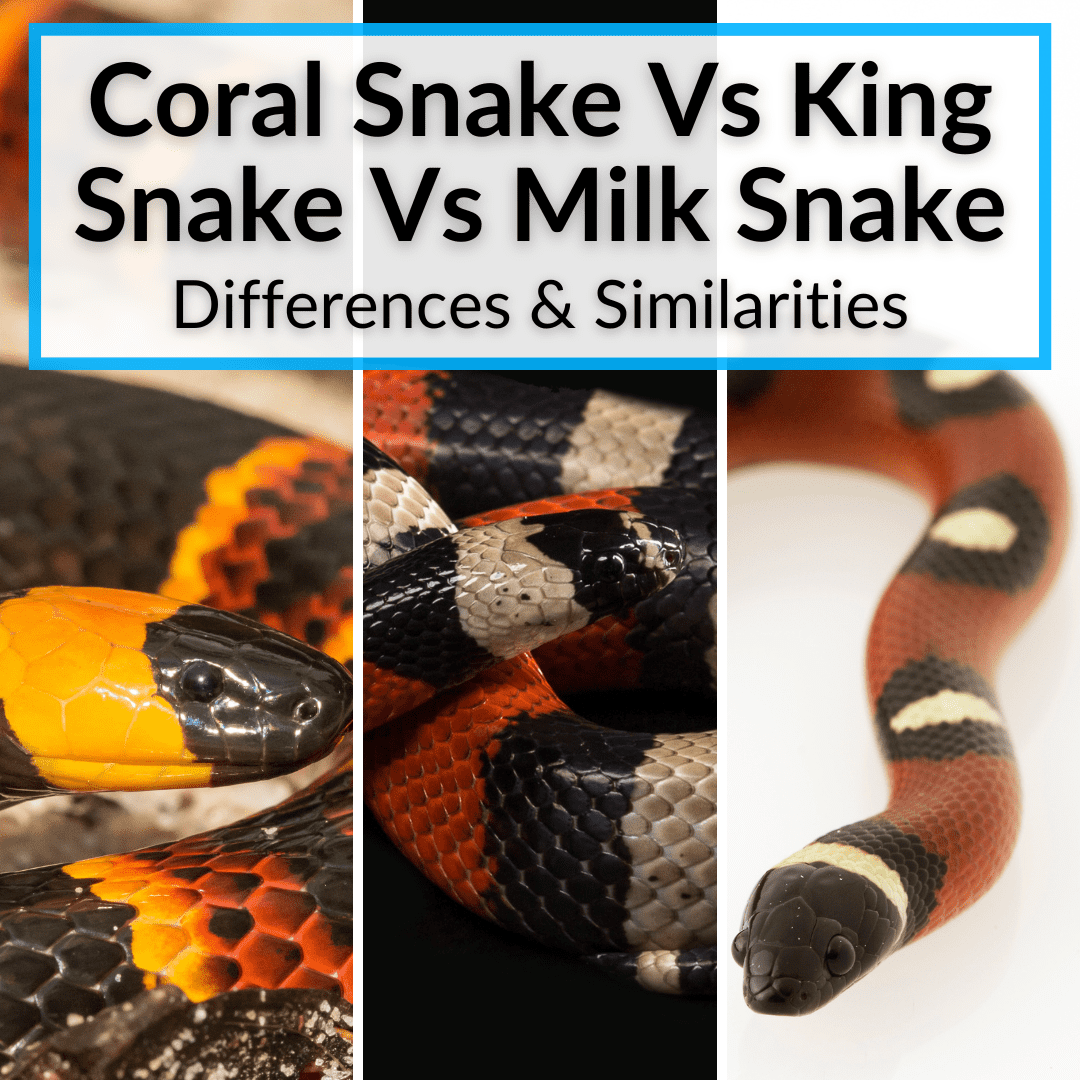
That’s because one of them is highly venomous, while the other two are harmless.
But they all look similar.
Luckily, there are key differences between the coral snake vs king snake vs milk snake.
If you know what to look for, you can easily tell them apart.
Keep reading to learn what sets these three snakes apart, so you know which one to avoid at all costs.
Table of Contents
Coral Snake Vs King Snake Vs Milk Snake
We will begin this comparison by looking at each snake individually, before comparing them with each other directly. The venomous coral snake is up first.
The Coral Snake
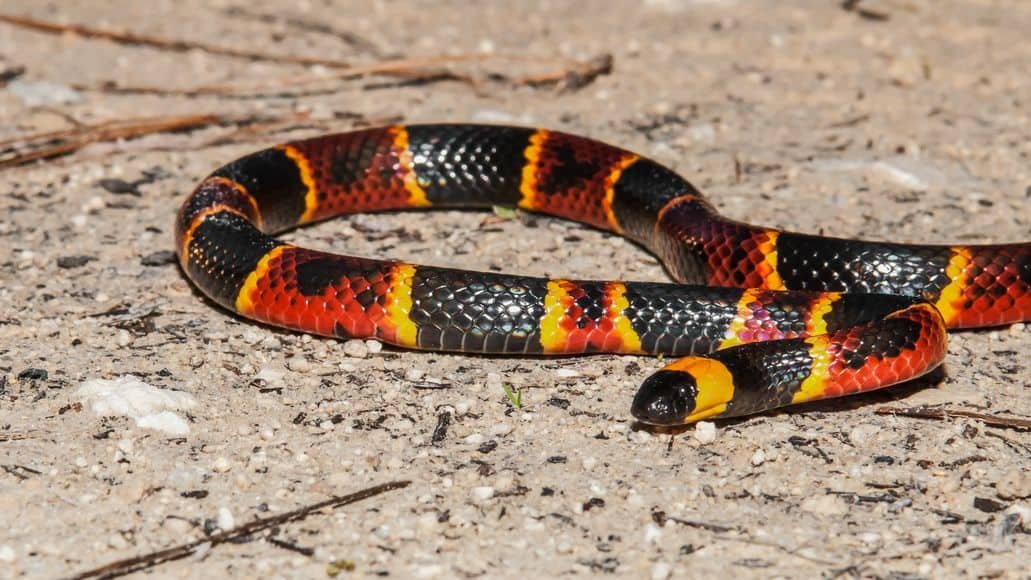
Coral snakes belong to the Elapid family. Elapid snakes have hollow teeth, and the venom comes out of small holes in their teeth. There are over 50 types of coral snakes.
Coral snakes are among the deadliest snakes in the world. The name ‘coral snakes’ was given to them by North American explorers who thought they looked like corals.
Description
Coral snakes are among the most beautiful snakes in the world. They are brightly colored and have bands of red, yellow, and black.
In the US, the coral snakes have red and yellow bands right next to each other, whereas the coral snakes in South America have black bands separating the red and yellow bands.
Most coral snakes measure 2 to4 feet (61 to 122 cm) although the longest coral snake was found to be almost 5 feet (over 150 cm)! Unlike many other venomous snake species, coral snakes have heads that are of the same width as their bodies.
Habitat
Coral snakes do not like low-lying areas or wet soil. They prefer well-drained sandy soils, grasslands, dry woods, and rocky hillsides. They usually live in logs, tree stumps, and piles of rotted leaves. They also inhabit the holes dug by other small animals.
Coral snakes are found in Central and South America and parts of Asia. In the United States, coral snakes are found throughout Florida (they are one of 6 venomous snakes in Florida), along the coastal plains of North Carolina, as well as Louisiana.
Habits
Coral snakes hide their heads under their bodies when they feel threatened. They rarely bite humans. They are usually nocturnal.
Coral snakes use their forked tongues to gain information from the smell and taste of the air. They rub their tongues against Jacobson’s organs which are tiny sacs at the top of their mouths containing taste and smell detectors.
Coral snakes do not have eardrums and their vision is also poorly developed. They molt 2 to 10 times a year, with older snakes molting less often than the younger ones.
Diet
What do coral snakes eat? They mainly feed on other small snakes, lizards, small birds, rodents, and mice. They even eat other coral snakes.
The King Snake
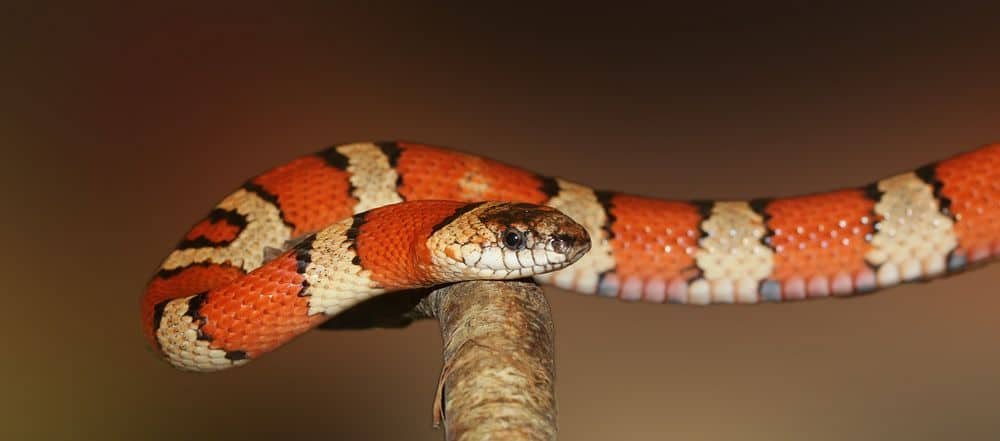
King snakes (also kingsnakes) belong to the Lampropeltis genus and the Colubridae family. The word Lampropeltis is Greek for ‘shiny shields’ meaning that these snakes have shiny or glossy scales.
The Colubridae family is the largest snake family, with more than 1000 snake species. King snakes are non-venomous, but they are constrictors, meaning they constrict their prey and suffocate it to death.
The got their name ‘King’, because of their behavior of ophiophagy, which refers to snakes eating snakes. (Ophiophagus being the Greek word for ‘snake eater’).
Description
King snakes are remarkably similar in appearance to coral snakes. They have smooth and glossy scales and beautiful patterns. Common kingsnakes are black or brown with narrow white or yellow bands.
Because of these patterns, common king snakes are sometimes called chain snakes. Some kingsnakes have red, gray, and lavender patterns. On top of their base color, they could have spots, bands, and stripes.
Kingsnakes vary in size. The scarlet kingsnake only measures 20 inches or 51 cm. Others, like the common kingsnake, are nearly 6 ft long.
Habitat
Kingsnakes live in North and South America. You can find them anywhere between the northeastern United States to California. Most kingsnake species are found on sandy islands, overgrown pastures, and rocky mountains.
Habits
Kingsnakes are secretive snakes that prefer hiding in burrows, out of sight. In cool climates, they hibernate by finding a den and sleeping throughout the winter. They become active again when the weather becomes warmer.
Diet
As mentioned earlier, kingsnakes eat other snakes, including rattlesnakes. They have even developed immunity to the venom of venomous snakes in their habitat, so they can survive being bitten by them.
The Milk Snake
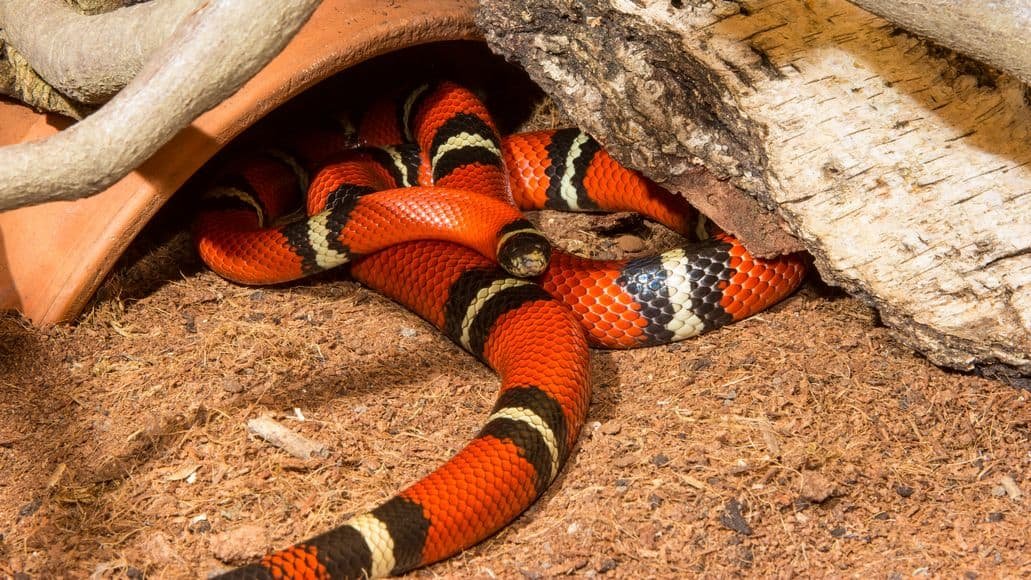
Milk snakes are not the color of milk. They got their name because farmers thought that they drank milk from their cows.
We know today that milk snakes do not drink milk. Instead, they are found in barns and cow sheds because they hunt for mice there. However, their name has stuck. All milk snakes are a type of kingsnake.
Description
Milk snakes are brightly colored snakes with shiny bodies. They have red, orange, brown, or grey colors. They also have black and yellow (or white) rings.
Different sub-species of milk snakes have different colors and patterns. The pale milk snake has a whitish body with orange or red spots that are bordered with black rings. An eastern milk snake has tan, brown, grey, or brick-red blotches and a V or Y-shaped patch of tan on the back of its neck.
Habitat
The optimum habitat for a milk snake is an open woodland with a ground cover of short grass or sparse vegetation and where the ground is generously littered with rocks.
Habits
Eastern milk snakes are shy creatures. They prefer to stay hidden under rocks or in logs. Most eastern milk snakes are nocturnal although some sub-species may be active all the time, as long as the weather is not too cold.
Are milk snakes poisonous? No, milk snakes are not poisonous at all. They are not venomous either. As mentioned, they are often mistaken for the venomous coral snake, but milk snakes are completely harmless.
Diet
Milk snakes usually eat small rodents and mammals, other snakes, birds and their eggs, and slugs.
Differences Between Coral Snakes, King Snakes, and Milk Snakes
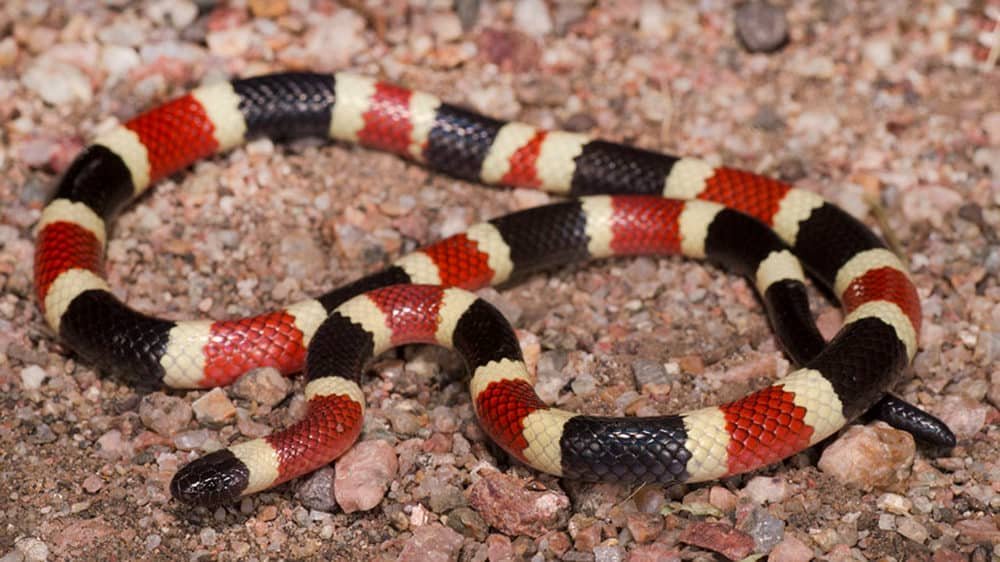
There are a number of important differences between milk snakes, kingsnakes and coral snakes. The most important is that coral snakes are highly venomous.
Venom
The main difference between a coral snake, milk snake, and king snake is in the venom. The coral snake is venomous, whereas the other two snakes are harmless.
To remember this, you can remember the rhyme “red on yellow kills a fellow, red on black, nice to Jack.” In a coral snake, the red and yellow rings touch each other, whereas in king snakes and milk snakes, the red and yellow bands are separated from each other by black bands or black rings.
Size And Appearance
Coral snakes are typically larger than milk snakes. Most coral snakes measure over 3 feet, whereas milk snakes are usually shorter than 3 feet in length. However, this is not a surefire method of identifying a milk snake since many milk snake species are known to grow over 5 feet!
Coral snakes also have a solid black head with a yellow band directly below the black marking. They also have a short snout. Milk snakes have a whitish V or Y-shaped marking below the head on the neck. The kingsnake has a red-colored head with an elongated snout.
Location
Coral snakes are found in Arizona, parts of Texas, Florida, Missouri, Alabama, and South and North Carolina. Kingsnakes are mostly found in Oregon, southern California, New Mexico, Texas, and Arizona. Milk snakes are found in Maine, Minnesota, Tennessee, and western North Carolina.
Here is a table summarizing all the differences between the coral snake, the king snake, and the milk snake.
| Coral Snake | King Snake | Milk Snake | |
|---|---|---|---|
| Description | Slender body, smooth scales, jet black head sometimes speckled, brown body, black ring near the tail. 18-47 in (61-120 cm) in length, blunt snout, red-yellow-black rings. Red touches yellow rings. | Usually black with creamy yellow bands, brown with yellow bands, black with a white vertical stripe, brown with yellow stripe, or speckled patterns. Measure about 3-5 feet. Red and yellow bands separated by black bands | Usually gray and reddish-brown coloring with a spotted pattern. Measure between 2-4 feet. Red and yellow/white rings or bands separated by black. |
| Snout | Short | Elongated | Elongated |
| Head | Black colored | Red colored | Whitish V or Y-shaped marking below the head |
| Venomous | Yes | No | No |
| Habitat | They prefer well-drained sandy soils, grasslands, dry woods, and rocky hillsides. They usually live in logs, tree stumps, and piles of rotted leaves. They also inhabit the holes dug by other small animals. | They live in sandy islands, overgrown pastures, and rocky mountains. | They prefer woodlands with a ground cover of short grass or sparse vegetation and where the ground is generously littered with rocks. |
| Diet | Other snakes, rats, rodents, birds, lizards, etc. | Other snakes like rattlesnakes. They have even developed immunity to the venom of venomous snakes. They also eat rats, lizards, birds, eggs, etc. | Small rodents and mammals, other snakes, birds, bird eggs, and slugs. |
Similarities Between Coral Snakes, Kingsnakes, and Milk Snakes
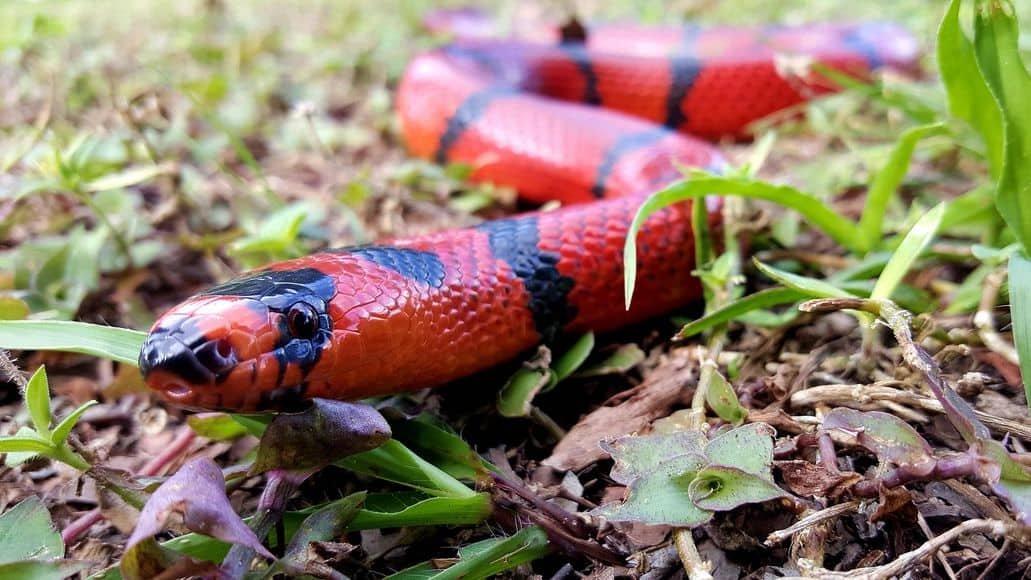
The main similarity between the three is their colors. All three species have similar coloring, typically red, yellow, and black markings. Both made it onto our list of snakes with the most amazing patterns.
Kingsnakes and milksnakes are both non-venomous and they have black bands touching the red bands. Coral snakes are venomous, and their red rings or bands touch the yellow/white bands.
Coral and kingsnakes have similar diets: they both eat lizards, frogs, birds, bird eggs, and other snakes. Milk snakes also eat small lizards, rodents, mammals, slugs, birds, and their eggs.
Coral Vs King Vs Milk Snakes: Final Thoughts
All three of these snakes look very similar, which can be a problem, since the coral snake is highly venomous, while the other two are not and pose no danger to us.
The good news is that you can easily tell the three snakes apart if you know what to look for. The rhyme we gave you above can ensure you never forget the key difference in color pattern.
Leave a Reply